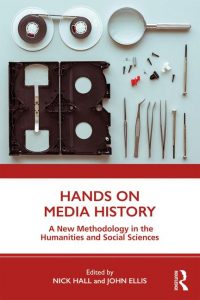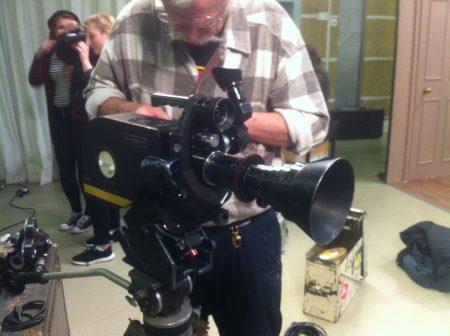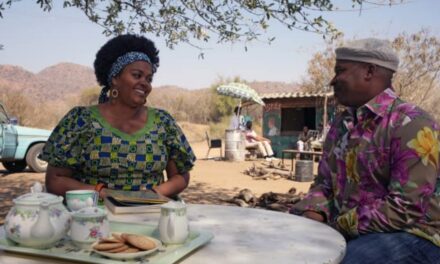
Hands on Media History: A New Methodology in the Humanities and Social Sciences. Eds. Nick Hall and John Ellis. Routledge, 2019.
Media practice remains under-theorised. What actually happens when media artefacts are made is the last great mystery in our subject area. Practice is now a major part of many degrees, but those who teach it tend to have an inferiority complex in relation to their Theory Colleagues. The knowledge that practice imparts is seen as ‘skills’, a term that designates a lesser form of knowledge. This has allowed some Theory Colleagues to disguise their own lack of those skills and to shelter behind an outdated myth of the intellectual. This myth has its roots in the struggle of thinkers to free themselves from the encumbrances of physical work in order to be able to think and write at all. This privilege, incidentally, was initially gained at the expense of women and servants who shouldered the burdens of existence as the thinking took place. Since that point, thinking has become a universal rather than the privilege of the few, a development spurred by universal literacy and suffrage. But the myth of the cerebral intellectual still persists.
We are now in a different phase of history. As our society becomes ever more technologized, it is becoming clear that ‘skills’ are themselves are the basis of thought itself: a ‘skill’ is in fact an adaptation by a human to a new circumstance of action. The acquisition of a skill requires thinking through objects to negotiate a way to a new creation or to a new way of existing. This is a process of mutual adaptation. The human alters their body to suit the object, and the object is designed and altered to suit the human.
As I argue in an essay in our new collection Hands On Media History, a skilled individual is in fact a new hybrid (following on from Latour’s notion of the ‘tooled body’). The skilled cameraperson using a lightweight camera (a ‘filmer’ would be a simpler expression) is a combination of camera and person, an agent capable of reflection and action in a new way.
The camera is a prosthesis which allows the extension and mutation of human perception and action into a new field. The camera takes the human capacity of vision and allies it to the process of recording. As part of a larger ensemble of technologies, it participates in a process that brings that recorded event to others who can observe in tranquillity. The new hybrid agent of camera and filmer extends that capacity for recorded seeing by giving it a mobility within the action being filmed as it develops.
It provides the ability to follow and observe human actors, to shift focus and attention within a space, to reframe according to the dictates of the action or the editorial preoccupations of the filmer. This new hybrid actor is capable of a new kind of intervention in events that is qualitatively different from that of the eye witness, and enables a further new kind of seeing in those who witness events through the recorded and edited images and sounds. The filmer effectively rethinks time, space and events for a new category of absent and distant viewer. We are still working through the implications of this new hybrid actor for society. (p.20)
Looking at practice in this way reveals its complexity. It also implies a new way of regarding though: thought in this context is not an abstract process of reflection but a ‘material engagement’ in the terms of Lambros Malafouris (How Things Shape the Mind: A Theory of Material Engagement, MIT Press 2013). From his perspective as an archaeologist, he analyses the process of knapping a flint to create tools:
Instead of seeing in the shaping of the handaxe the execution of a preconceived ‘internal’ mental plan, we should see an ‘act of embodying.’ … In tool making, most of the thinking happens where the hand meets the stone. There is little deliberate planning, but there is a great deal of approximation, anticipation, and guessing about how the material will behave. … Sometimes the material collaborates; sometimes it resists. In time, out of this evolving tension comes precision and thus skillfulness. Knapping, then, should be seen more as an active ‘exploration’ than as a passive ‘externalization’ or ‘imposition of form’. (Malafouris p.235)
It is not much of a stretch to see this as a description of the activity of editing footage into a coherent film. It is the engagement with material that enables thinking.
In this approach lies the possibility of understanding media practice in a new way, as physical form of thinking in time and space. Hands On Media History shows that the true complexity of media skills can be revealed through encounters with objects that once had skilled users (video games, Walkmans) or engagement with analogue technologies, whether the earliest form of photography using vegetable dyes, or activities like those of the Dead Media Streaming Service. From such encounters comes an understanding of skills that once existed, the adaptations that humans made to their technologies, the processes involved, and the affordances that skilled users were once able to exploit.
John Ellis is Professor of Media Arts at Royal Holloway University of London. He leads the ADAPT project on the history of technologies in TV, funded by a €1.6 million grant from the European Research Council. He is the author of Documentary: Witness and Self-revelation (Routledge 2011), TV FAQ (IB Tauris 2007), Seeing Things (IB Tauris 2000) and Visible Fictions (1984). Between 1982 and 1999 he was an independent producer of TV documentaries through Large Door Productions, working for Channel 4 and BBC. He is chair of Learning on Screen and also oversees the Royal Holloway team working on EUscreen. His publications can be found HERE.





![BRUCE’S CHOICE <br> by not only Andrew Pixley [i]](https://cstonline.net/wp-content/uploads/2020/06/BrucesChoice_image02-440x264.png)